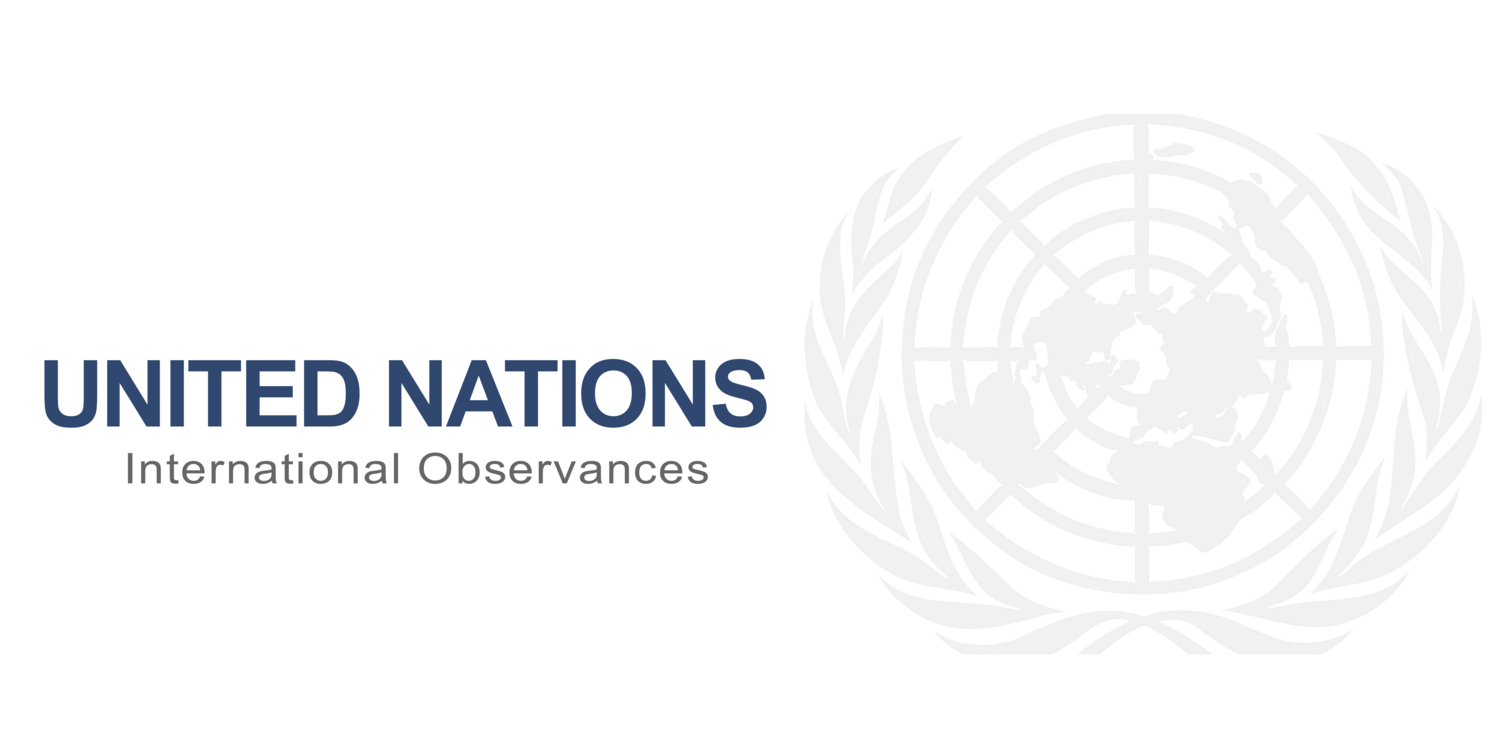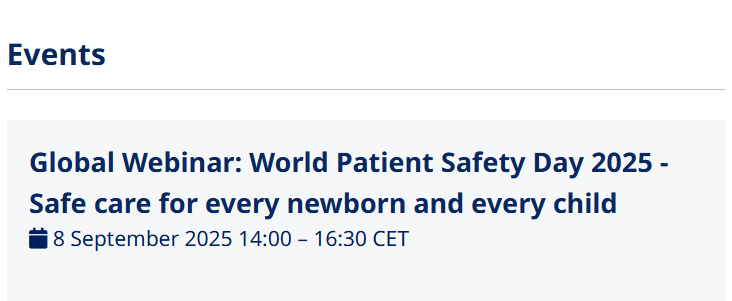PURPOSE: Patient and family engagement was embedded in the Resolution WHA72.6 – “Global action on patient safety” and the Global Patient Safety Action Plan 2021-2030 as main strategies for moving towards eliminating avoidable harm in health care.The resolution recognizes patient safety as a global health priority and endorses the establishment of World Patient Safety Day to be observed annually on 17 September. The purpose of World Patient Safety Day is to promote patient safety by increasing public awareness and engagement, enhancing global understanding and working towards global solidarity and action. The observance of the Day calls for global solidarity and concerted action by all countries and international partners to improve patient safety. The Day brings together patients, families, caregivers, communities, health workers, health care leaders and policy-makers to show their commitment to patient safety.
FORUM: "Safe care for every newborn and every child." World Patient Safety Day 2025.Every child has the right to safe, quality health care — from the very beginning. Yet, newborns and young children face higher risks due to their rapid development, evolving health needs and different disease patterns. They rely on adults to speak up and make decisions for them. Children may also face added challenges depending on their socio-economic circumstances, such as not being able to get the care they need. These factors make them more susceptible to harm if care isn’t specifically adapted to their age, size, health condition and context. A single safety incident can have lifelong consequences for a child’s health and development. That’s why World Patient Safety Day 2025 is dedicated to ensuring safe care for every newborn and child, with a special focus on those from birth to nine years old. This year’s slogan, “Patient safety from the start!”, emphasizes the urgent need to act early and consistently to prevent harm throughout childhood, and yield benefits across the life course. The WHO calls on parents, caregivers, health practitioners, health care leaders, educators and communities, to unite in action to prevent avoidable harm in paediatric care and to build a safer, healthier future for every child, as part of the global effort to achieve Sustainable Development Goal 3. Let’s Work together to make health care safer. Follow the conversations with the hashtags: #17September, #worldpatientSafetyDay, #PatientSafety, #HealthForAll, #Engagingpatients.
EVENTS: On and around September 17th, to mark the World Patient Safety Day 2025, the WHO will host a global virtual conference with the aims to drive meaningful improvements and reaffirm every child's right to safe and quality care. This year, the theme is “Safe care for every newborn and every child”, with the slogan “Patient safety from the start!”, recognizing the vulnerability of this age group to risks and harm caused by unsafe care. The WHO calls for urgent action to eliminate avoidable harm in paediatric and newborn care, building on the efforts of previous campaigns on ‘safe childbirth’, ‘prioritizing patient safety’, ‘health worker safety’, ‘medication safety’, ‘patient and family engagement’ and ‘diagnostic safety. The Objectives of this event are to Raise global awareness of safety risks in paediatric and newborn care in all health care settings, emphasizing the specific needs of children, families and caregivers, to Mobilize governments, health care organizations, professional bodies and civil society to implement sustainable strategies for safer care for newborns and children, as part of broader patient safety and quality initiatives, to Empower parents, caregivers and children in patient safety by promoting education, awareness and active participation in care; To Advocate for strengthening research on patient safety in paediatric and newborn care.
On September 8th, 2025, from 14:00 to 16:30 CEST; You are invited to join the World Health Organization (WHO) and the Partnership for Maternal Newborn and Child Health (PMNCH) for a Global Webinar to mark the World Patient Safety Day 2025 under the slogan “Patient safety from the start!”. This webinar will bring together patient representatives, health leaders, frontline health workers and international partners to shed light on the preventable harm children face in health care, to share experiences and innovations from around the world, to launch the campaign materials and World Patient Safety Day 2025 Goals, and mobilize collective action to make care safer for every newborn and child. The Programme highlights include an Opening addresses from WHO and PMNCH leadership; a Keynote by the WHO Envoy for Patient Safety, Sir Liam Donaldson; The Voices of patients and frontline health workers; The Launch of the WPSD 2025 campaign materials and Goals; The Commentaries from experts and partners followed by Closing reflections. The celebration of the day will feature a range of activities, including national campaigns, advocacy events, technical activities and the illumination of iconic landmarks and public places in orange, the well-recognized signature mark of the campaign. For more information, please refer to the World Patient Safety Day 2025 announcement. Learn how to register to participate and For further questions, please contact: patientsafety@who.int.
From September 15 to 21, 2025; The World Health Organization (WHO) will organize the lighting up of Geneva’s Jet d’Eau in orange colour to demonstrate the Organization's dedication to this cause. The PAHO will illuminate its headquarters in Washington, D.C. Member States and partners are invited to participate in the global campaign by pledging to implement the WHO Global Patient Safety Challenge: Medication Without Harm, organizing activities, holding events and lighting up iconic monuments in orange in support of medication safety.
In Americas; on September 25th from 10:30 a.m. to 12:00 p.m., the PAHO will host a virtual seminar providing patients, decision-makers, healthcare teams, and academics the opportunity to discuss and share their insights on enhancing patient safety through more timely and accurate diagnoses. Register to participate!
STATEMENTS: Statement from the PAHO Director-general on World Patient Safety Day 2025; September 17th.
To promote global solidarity, WHO has also encouraged the creation of networking and collaborative initiatives such as the Global Patient Safety Network and the Global Patient Safety Collaborative. To recognize the importance of patients’ active involvement in the governance, policy, health system improvement and their own care, the WHO established the Patients for Patient Safety programme to foster the engagement of patients and families. The World Health Organization work to enhance patient experience, reduce risks and harm, achieve better health outcomes and lower costs.
Every year, millions of patients suffer injuries or die because of unsafe and poor-quality health care. Many medical practices and risks associated with health care are emerging as major challenges for patient safety and contribute significantly to the burden of harm due to unsafe care.
Below are some of the patient safety situations causing most concern.
Medication errors are a leading cause of injury and avoidable harm in health care systems: globally, the cost associated with medication errors has been estimated at US$ 42 billion annually.
Health care-associated infections occur in 7 and 10 out of every 100 hospitalized patients in high-income countries and low- and middle-income countries respectively.
Unsafe surgical care procedures cause complications in up to 25% of patients. Almost 7 million surgical patients suffer significant complications annually, 1 million of whom die during or immediately following surgery.
Unsafe injections practices in health care settings can transmit infections, including HIV and hepatitis B and C, and pose direct danger to patients and health care workers; they account for a burden of harm estimated at 9.2 million years of life lost to disability and death worldwide (known as Disability Adjusted Life Years (DALYs)).
Diagnostic errors occur in about 5% of adults in outpatient care settings, more than half of which have the potential to cause severe harm. Most people will suffer a diagnostic error in their lifetime.
Unsafe transfusion practices expose patients to the risk of adverse transfusion reactions and the transmission of infections. Data on adverse transfusion reactions from a group of 21 countries show an average incidence of 8.7 serious reactions per 100 000 distributed blood components.
Radiation errors involve overexposure to radiation and cases of wrong-patient and wrong-site identification. A review of 30 years of published data on safety in radiotherapy estimates that the overall incidence of errors is around 15 per 10 000 treatment courses.
Sepsis is frequently not diagnosed early enough to save a patient’s life. Because these infections are often resistant to antibiotics, they can rapidly lead to deteriorating clinical conditions, affecting an estimated 31 million people worldwide and causing over 5 million deaths per year.
Venous thromboembolism (blood clots) is one of the most common and preventable causes of patient harm, contributing to one third of the complications attributed to hospitalization. Annually, there are an estimated 3.9 million cases in high-income countries and 6 million cases in low- and middle-income countries.
Join the Communities of Practice on the WHO IHS Global Hub for updates on patient safety and quality of care.
PODCASTS: Patient safety from the start! Protecting every child’s health journey. Every person around the world will, at some point in their life, take medications to prevent or treat illness. However, medications sometimes cause serious harm if incorrectly stored, prescribed, dispensed, administered or if monitored insufficiently. Working together to make health care safer. Listen to the audio podcasts!
CAMPAIGN MATERIALS: The global campaign under slogan “Patient safety from the start!” will propose a wide range of activities for all stakeholders including national campaigns, policy forums, advocacy and technical events, capacity-building initiatives and, as in previous years, lighting up iconic monuments, landmarks and public places in the colour orange (the signature mark of the campaign). Explore the World Patient Safety Day Goals – 2025 - sign up to show support and Get the communication materials!
WHY WE CELEBRATE THE DAY?
HOW TO GET INVOLVED!
PARTNERSHIPS
World Patient Safety Day is one of WHO’s global public health days. It was established in 2019 by the 72nd World Health Assembly through the adoption of resolution WHA72.6 – “Global action on patient safety”. Its objectives are to increase public awareness and engagement, enhance global understanding, and work towards global solidarity and action by Member States to enhance patient safety and reduce patient harm.
Raise global awareness of the need for active engagement of patients and their families and caregivers in all settings and at all levels of health care to improve patient safety.
Engage policy-makers, health care leaders, health and care workers, patients’ organizations, civil society and other stakeholders in efforts to engage patients and families in the policies and practices for safe health care.
Empower patients and families to be actively involved in their own health care and in the improvement of safety of health care.
Advocate urgent action on patient and family engagement, aligned with the Global Patient Safety Action Plan 2021–2030, to be taken by all partners.
The World Patient safety Day is hosted by the WHO in:









